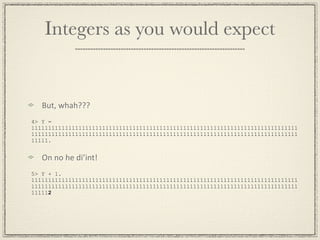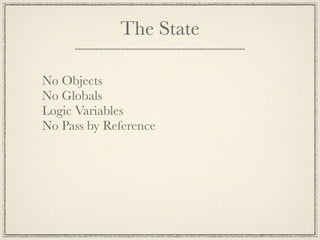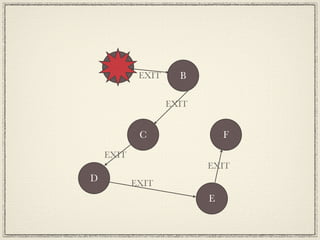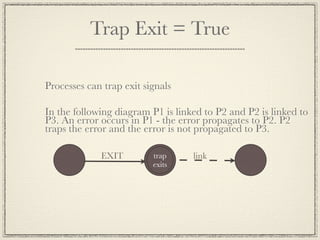Erlang bootstrap course
- 1. The Erlang Bootstrap Class The Erlang Basics Based on the 4 day Erlang course
- 2. What are we dealing with? Data Types Pattern Matching (makes functions fun) Modules Processes
- 3. Shell (learn it, love it) As critical to Erlang dev as fingers Your best tool for learning and experimenting Important facts Start with erl Stop with ctrl c, ctrl c q(). to kill nicely expressions end in a period
- 4. Shell Commands h() - history . Print the last 20 commands. b() - bindings. See all variable bindings. f() - forget. Forget all variable bindings. f(Var) - forget. Forget the binding of a variable Var. * This can ONLY be used as a command to * the shell - NOT in the body of a function! e(n) - evaluate. Evaluate the n:th command in history. e(-1) - Evaluate the previous command. * Edit the command line as in Emacs * See the User Guide for more details and examples of use of the shell.
- 5. Calculations in the Shell You can add! 1> 1 + 1. 2 You can assign values to variables! 2> X = 2. 2 3> X + 1. 3
- 6. Integers as you would expect But, whah??? 4> Y = 1111111111111111111111111111111111111111111111111111111111111111111111111111111 1111111111111111111111111111111111111111111111111111111111111111111111111111111 11111. On no he di’int! 5> Y + 1. 1111111111111111111111111111111111111111111111111111111111111111111111111111111 1111111111111111111111111111111111111111111111111111111111111111111111111111111 111112
- 7. Floats Alas, not freaky (plain ol’ 64 bit double‐precision) 6> 1.1234567890123456789012345678901234567890. 1.1234567890123457 An unusual conversion from float to int 1> X = 1.12345. 1.12345 2> is_float(X). true 3> Y = erlang:trunc(X). 1 4> is_integer(Y). true
- 8. Lists Most common data structure. Used for storing a variable number of elements. [123, xyz] [ {person, 'Joe', 'Armstrong'}, {person, 'Robert', 'Virding'}, {person, 'Mike', 'Williams'} ]
- 9. Strings (haven’t we seen these before?) PreGy much what you’d expect 1> Slogan = "Mongo DB is Web Scale". "Mongo DB is Web Scale" But, wait, OMG, noooo! 2> io_lib:format("Mongo DB is ~s", ["Web Scale"]). [77,111,110,103,111,32,68,66,32,105,115,32,"Web Scale"] Yep, strings are just lists! 3> is_string(Slogan). ** exception error: undefined shell command is_string/1 4> is_list(Slogan). true
- 10. Binaries SomeMmes used to represent strings <<"This is a binary">> is_binary differenMates from is_list More typically used to work with actual binary data (e.g. bitstring syntax – not covered in this presentaMon) Have protocol, will use binaries/bitstrings!
- 11. Variables (not very variable) More of a definition than a variable. They dont actually ever vary Abc A_long_non_standard_variable_name AProperErlangVariableName * Start with an Upper Case Letter. * No "funny characters". * Variables are used to store values of data structures.
- 12. Tuples pretty much the “struct” thingy for erlang {123, bcd} {abc, {def, 123}, jkl} {} {atom() = Tag, term() = Value} % very erlangy {error, {“value was bad”, 9}}
- 13. Pattern Matching
- 14. A = 10 Succeeds - binds A to 10 {B, C, D} = {10, foo, bar} Succeeds - binds B to 10, C to foo and D to bar {A, A, B} = {abc, abc, foo} Succeeds - binds A to abc, B to foo {A, A, B} = {abc, def, 123} Fails [A,B,C] = [1,2,3] Succeeds - binds A to 1, B to 2, C to 3 [A,B,C,D] = [1,2,3] Fails
- 15. [A,B|C] = [1,2,3,4,5,6,7] Succeeds - binds A = 1, B = 2, C = [3,4,5,6,7] [H|T] = [1,2,3,4] Succeeds - binds H = 1, T = [2,3,4] [H|T] = [abc] Succeeds - binds H = abc, T = [] [H|T] = [] Fails {A,_, [B|_Tail],{B}} = {abc,23,[22,x],{22}} Succeeds - binds A = abc, B = 22
- 17. ToDo List Let’s make a list! 1> ToDo = ["Shard /dev/null", "Learn Ruby", "Remove Bing from Phone"]. Write to disk (easy to encode Erlang!) 2> file:write_file("todo.bin", term_to_binary(ToDo)). ok Read from disk (easy to decode Erlang!) 3> {ok, Bin} = file:read_file("todo.bin"). {ok,<<131,108,0,0,0,3,107,0,15,83,104,97,114,100,32,47, 100,101,118,47,110,117,108,108,107,0,10,...>>} 4> binary_to_term(Bin). ["Shard /dev/null","Learn Ruby","Remove Bing from Phone"]
- 18. Standard Libraries Second most important Erlang developer tool: a decent module reference hGp://erlang.org/doc/man_index.html hGp://erldocs.com/ The file module provides an interface to the file system We will keep using them – keep an eye out
- 19. Module System -module(demo). -export([double/1]). double(X) -> times(X, 2). times(X, N) -> X * N.
- 20. Using lists Comma separated Erlang terms surrounded by brackets [this, is, "a", {List, [of, stuff]}] Used ehhhverywhere An important paGern for iteraMve operaMons lists:map/2 list comprehension The basis for “associaMve array” structure in Erlang (proplist) [{foo, "Foo" 123}] 1> L1 = [2, 3]. [2,3] 2> L2 = [1|L1]. [1,2,3] 3> [H|T] = L2. [1,2,3] 4> H. 1 5> T. [1,2]
- 21. Built In Functions (BIFs) date() time() length([1,2,3,4,5]) size({a,b,c}) atom_to_list(an_atom) list_to_tuple([1,2,3,4]) integer_to_list(2234) tuple_to_list({})
- 22. Lets do something more with lists A basic sort 5> lists:sort(ToDo). ["Learn Ruby","Remove Bing from Phone","Shard /dev/null"] Wait, that’s not what I want! 6> ToDo2 = [{2, "Shard /dev/null"}, {3, "Learn Ruby"}, {1, "Remove Bing from Phone"}]. 7> lists:sort(ToDo2). [{1,"Remove Bing from Phone"}, {2,"Shard /dev/null"}, {3,"Learn Ruby"}] Default sort comparison uses “natural order” of Erlang term We don’t need no sMnking natural order! 8> lists:sort( fun({P1, N1}, {P1, N2}) -> N1 < N2 end, ToDo2). [{3,"Learn Ruby"}, {1,"Remove Bing from Phone"}, {2,"Shard /dev/null"}
- 23. Lambda Functions Use fun to create a funcMon from within a funcMon Use a fun to pass funcMonality around like any other data structure Anonymous funcMons have access to variables visible within their defining block, even when executed elsewhere 1> X = 1. 1 2> F = fun(Y) -> X + Y end. #Fun<erl_eval.6.13229925> 3> F(10). 11
- 24. Function Heads Is defined as a collection of clauses. func(Pattern1, Pattern2, ...) -> ... ; func(Pattern1, Pattern2, ...) -> ... ; ... func(Pattern1, Pattern2, ...) -> ... .
- 25. Guards is_number(X) - X is a number is_integer(X) - X is an integer is_float(X) - X is a float is_atom(X) - X is an atom is_tuple(X) - X is a tuple is_list(X) - X is a list length(X) == 3 - X is a list of length 3 size(X) == 2 - X is a tuple of size 2. X > Y + Z - X is > Y + Z
- 27. The State No Objects No Globals Logic Variables No Pass by Reference
- 28. In the Loop Your State
- 29. Side Effects - Side effects are not “evil” - any IO is a side effect - anything not “referentially transparent” - Make function substitution difficult - Side effects can catch you off guard. Be prepared.
- 31. Creating a New Process Code in Pid1 Pid2 = spawn(Mod, Func, Args) After Pid2 is process identifier of the new process - this is known only to process Pid1.
- 32. Message Passing {PidA, foo} A B receive PidB ! {self(), foo} {From, Msg} -> Actions end
- 33. Echo Client -module(echo). -export([go/0]). go() -> Pid2 = spawn(fun() -> loop() end), Pid2 ! {self(), hello}, receive {Pid2, Msg} -> io:format("P1 ~w~n", [Msg]) end, Pid2 ! stop.
- 34. Echo Server loop() -> receive {From, Msg} -> From ! {self(), Msg}, loop(); stop -> true end.
- 35. Selective Message Reception first foo then bar A receive PidC ! foo foo -> ... C end, receive bar -> ... end B PidC ! bar
- 36. sleep(T) -> receive after T -> true flush() -> end. receive {echo, Msg} -> flush() suspend() -> after receive 0 -> true after end. infinity -> true end.
- 37. Beefy Echo - Not just echo anymore - Fun with Funs - Call a process by a name
- 38. Now it gets interesting Fault Tolerance
- 39. Exit Signals EXIT EXIT EXIT Exit Signals are Sent when Processes Crash When a process crashes (e.g. failure of a BIF or a pattern match) Exit Signals are sent to all processes to which the failing process is currently linked.
- 40. A EXIT B EXIT C F EXIT EXIT D EXIT E
- 41. Trap Exit = True Processes can trap exit signals In the following diagram P1 is linked to P2 and P2 is linked to P3. An error occurs in P1 - the error propagates to P2. P2 traps the error and the error is not propagated to P3. EXIT trap link exits
- 42. Put up with Sh!t result parsed input data stream
- 43. Distribution
- 44. Single VM Single machine communication VM A on Machine A Y ! msg X Y VM A on Machine A VM B on Machine B Y ! msg X Y Multiple VM network communication
- 45. Registered process local communication VM A on Machine A reg ! msg X reg VM A on Machine A VM B on Machine B {reg, B} ! msg X reg Registered process network communication
- 46. Topology with Cookies erl -name <name> -setcookie foo erl -name <name> -setcookie bar
Editor's Notes
- #2: \n
- #3: \n
- #4: \n
- #5: \n
- #6: \n
- #7: \n
- #8: \n
- #9: \n
- #10: \n
- #11: \n
- #12: \n
- #13: \n
- #14: \n
- #15: \n
- #16: Note the use of "_", the anonymous (don't care) variable.\n Note the use of _Tail. This is also a don't care var that instructs \n the compiler not to produce a warning. It equally efficient as _ and preferred. \n\n
- #17: \n
- #18: \n
- #19: \n
- #20: * double can be called from outside the module, times is local to the module.\n * double/1 means the function double with one argument (Note that double/1 and double/2 are two different functions). \n\nLets put our todo list into a module. Show module todo_list.erl from code section.\n
- #21: \n
- #22: * Are in the module erlang.\n * Do what you cannot do (or is difficult to do) in Erlang.\n * Modify the behaviour of the system.\n * Described in the BIFs manual. \n
- #23: Show the module todo_list at hash \n
- #24: Doing something more with lists involved the use of lambda functions\n
- #25: Next we use the example file in git called fib.erl to show iteration via recursion and the use of case and function head pattern matching.\n
- #26: Next we use the example file in git called fib.erl to show iteration via recursion and the use of case and function head pattern matching.\n
- #27: \n
- #28: Where the hell is the state in Erlang?\n
- #29: State is held in process loops. Messaging is your big old global variable should you choose to use it that way. But the one difference is, messaging is copy everything share nothing. No shared state then. The yoke of the tyrant is off almost - this is still a side effect. It may not deadlock but it can still result in the unexpected.\n
- #30: Keep your side effects isolated\n
- #31: \n
- #32: \n
- #33: self() - returns the Process Identity or "Pid" of the process executing this function.\n
- #34: \n
- #35: \n
- #36: \n
- #37: \n
- #38: Can anyone tell me why this is horrible. \nBreaks all kinds of encapsulation rules. That will be a topic for later though. \n
- #39: \n
- #40: \n
- #41: This is a picture of exit signals propagating through links. \n
- #42: \n
- #43: Supervision and layering\nThe result processor processes don&#x2019;t care what happens to the lower level processes so long as they produce complete results at an acceptable frequency. \nDoes not get much cooler. Targus proxy at vail lived through a storm of shit. \nMini reboots - just like windows only smaller\n
- #44: \n
- #45: \n
- #46: \n
- #47: \n








![Lists
Most common data structure. Used for storing a variable
number of elements.
[123, xyz]
[
{person, 'Joe', 'Armstrong'},
{person, 'Robert', 'Virding'},
{person, 'Mike', 'Williams'}
]](https://image.slidesharecdn.com/erlangbootstrapcourse-110919032210-phpapp02/85/Erlang-bootstrap-course-8-320.jpg)
![Strings (haven’t we seen these before?)
PreGy
much
what
you’d
expect
1> Slogan = "Mongo DB is Web Scale".
"Mongo DB is Web Scale"
But,
wait,
OMG,
noooo!
2> io_lib:format("Mongo DB is ~s", ["Web Scale"]).
[77,111,110,103,111,32,68,66,32,105,115,32,"Web Scale"]
Yep,
strings
are
just
lists!
3> is_string(Slogan).
** exception error: undefined
shell command is_string/1
4> is_list(Slogan).
true](https://image.slidesharecdn.com/erlangbootstrapcourse-110919032210-phpapp02/85/Erlang-bootstrap-course-9-320.jpg)




![A = 10
Succeeds - binds A to 10
{B, C, D} = {10, foo, bar}
Succeeds - binds B to 10, C to foo and D
to bar
{A, A, B} = {abc, abc, foo}
Succeeds - binds A to abc, B to foo
{A, A, B} = {abc, def, 123}
Fails
[A,B,C] = [1,2,3]
Succeeds - binds A to 1, B to 2, C to 3
[A,B,C,D] = [1,2,3]
Fails](https://image.slidesharecdn.com/erlangbootstrapcourse-110919032210-phpapp02/85/Erlang-bootstrap-course-14-320.jpg)
![[A,B|C] = [1,2,3,4,5,6,7]
Succeeds - binds A = 1, B = 2,
C = [3,4,5,6,7]
[H|T] = [1,2,3,4]
Succeeds - binds H = 1, T = [2,3,4]
[H|T] = [abc]
Succeeds - binds H = abc, T = []
[H|T] = []
Fails
{A,_, [B|_Tail],{B}} = {abc,23,[22,x],{22}}
Succeeds - binds A = abc, B = 22](https://image.slidesharecdn.com/erlangbootstrapcourse-110919032210-phpapp02/85/Erlang-bootstrap-course-15-320.jpg)

![ToDo List
Let’s
make
a
list!
1> ToDo = ["Shard /dev/null",
"Learn Ruby",
"Remove Bing from Phone"].
Write
to
disk
(easy
to
encode
Erlang!)
2> file:write_file("todo.bin", term_to_binary(ToDo)).
ok
Read
from
disk
(easy
to
decode
Erlang!)
3> {ok, Bin} = file:read_file("todo.bin").
{ok,<<131,108,0,0,0,3,107,0,15,83,104,97,114,100,32,47,
100,101,118,47,110,117,108,108,107,0,10,...>>}
4> binary_to_term(Bin).
["Shard /dev/null","Learn Ruby","Remove Bing from Phone"]](https://image.slidesharecdn.com/erlangbootstrapcourse-110919032210-phpapp02/85/Erlang-bootstrap-course-17-320.jpg)

![Module System
-module(demo).
-export([double/1]).
double(X) ->
times(X, 2).
times(X, N) ->
X * N.](https://image.slidesharecdn.com/erlangbootstrapcourse-110919032210-phpapp02/85/Erlang-bootstrap-course-19-320.jpg)
![Using lists
Comma
separated
Erlang
terms
surrounded
by
brackets
[this, is, "a", {List, [of, stuff]}]
Used
ehhhverywhere
An
important
paGern
for
iteraMve
operaMons
lists:map/2
list
comprehension
The
basis
for
“associaMve
array”
structure
in
Erlang
(proplist)
[{foo, "Foo"
123}]
1> L1 = [2, 3].
[2,3]
2> L2 = [1|L1].
[1,2,3]
3> [H|T] = L2.
[1,2,3]
4> H.
1
5> T.
[1,2]](https://image.slidesharecdn.com/erlangbootstrapcourse-110919032210-phpapp02/85/Erlang-bootstrap-course-20-320.jpg)
![Built In Functions (BIFs)
date()
time()
length([1,2,3,4,5])
size({a,b,c})
atom_to_list(an_atom)
list_to_tuple([1,2,3,4])
integer_to_list(2234)
tuple_to_list({})](https://image.slidesharecdn.com/erlangbootstrapcourse-110919032210-phpapp02/85/Erlang-bootstrap-course-21-320.jpg)
![Lets do something more with lists
A
basic
sort
5> lists:sort(ToDo).
["Learn Ruby","Remove Bing from Phone","Shard /dev/null"]
Wait,
that’s
not
what
I
want!
6> ToDo2 = [{2, "Shard /dev/null"},
{3, "Learn Ruby"},
{1, "Remove Bing from Phone"}].
7> lists:sort(ToDo2).
[{1,"Remove Bing from Phone"},
{2,"Shard /dev/null"},
{3,"Learn Ruby"}]
Default
sort
comparison
uses
“natural
order”
of
Erlang
term
We
don’t
need
no
sMnking
natural
order!
8> lists:sort(
fun({P1, N1}, {P1, N2}) -> N1 < N2 end,
ToDo2).
[{3,"Learn Ruby"},
{1,"Remove Bing from Phone"},
{2,"Shard /dev/null"}](https://image.slidesharecdn.com/erlangbootstrapcourse-110919032210-phpapp02/85/Erlang-bootstrap-course-22-320.jpg)










![Echo Client
-module(echo).
-export([go/0]).
go() ->
Pid2 = spawn(fun() -> loop() end),
Pid2 ! {self(), hello},
receive
{Pid2, Msg} -> io:format("P1 ~w~n",
[Msg])
end,
Pid2 ! stop.](https://image.slidesharecdn.com/erlangbootstrapcourse-110919032210-phpapp02/85/Erlang-bootstrap-course-33-320.jpg)












